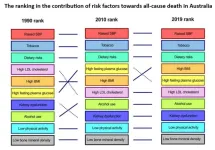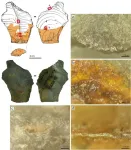(Press-News.org) Body composition — often expressed as the amount of fat in relation to muscle — is one of the standard predictors of cardiac health. Now, new research from the University of California San Diego indicates more muscle doesn’t automatically mean lower risk of heart trouble.
The study, published in the Journal of the American Heart Association, found all muscle isn’t the same. Britta Larsen, PhD, says men with a higher area of abdominal muscle have a greater risk of cardiac trouble. It’s a completely different story for men with greater muscle density. The denser the muscle, the better: Men with the densest muscle in their abdominal cavity had about one quarter the risk of coronary heart disease later on.
“And the other really important thing to note is that we didn't find this with women. It was just in men,” said Larsen, lead author and associate professor in the UC San Diego Herbert Wertheim School of Public Health and Human Longevity Science.
The data were taken from computed tomography of subjects in the National Institutes of Health Multi-Ethnic Study of Atherosclerosis, or MESA. Larsen explained that the subjects were in their mid-60s when the study — aimed at the understanding of the thickening of the arteries — began in the year 2000. Participants were recruited from numerous places around the U.S. and had follow-up visits for 20 years. Larsen noted that her group followed the subjects’ medical records for 12 years.
The researchers found that the large-muscle group’s heart-disease risk was as much as six times higher than the group of men with the smallest abdominal muscle area. Larsen said the team was surprised by the correlation of higher muscle area with higher coronary heart disease.
“Muscle has been overlooked in health for a long time,” Larsen said. “Researchers have really just focused on fat. But muscle is a large, active metabolic tissue, and it's finally getting a little bit more attention.”
Larsen explains the distinction between muscle area and muscle density boils down to quantity vs quality. The computed tomography scans render a two-dimensional image. Muscle area, she said, was determined simply by pixel count in the image.
“Density is a little bit trickier. It's sort of our proxy measure of muscle quality,” Larsen said. “It's really a measure of how much fat has infiltrated the muscle cavity. Within the muscle itself, how much is pure muscle? And how much is fat content?”
The study also found no correlation between muscle and stroke, among men as well as women. The researchers drew a distinction between coronary heart disease and cardiovascular disease, which includes stroke — a block in the artery outside the heart.
“What that tells me is that muscle density isn't just sort of a proxy measure of overall health or frailty or aging,” she said. “Otherwise, we would see it with stroke and other outcomes, too.”
Larsen said the work raises many more questions and possible avenues for future research. For instance: Why are women seemingly exempt from the muscle/coronary connection?
Larsen said a larger question concerns the biological mechanisms driving the muscle/coronary connection in men. Genetics could be involved, but she said her suspicions turn to diet and physical activity.
Co-authors on the paper from UC San Diego’s Herbert Wertheim School of Public Health and Human Longevity Science include John Bellettiere, Rowena M. Tam and Rita Ryu. Other UC San Diego co-authors include Matthew Allison, Michael Criqui and Jonathan Unkart, all of the Department of Family Medicine & Public Health at UC San Diego; Robyn L. McClelland, Department of Biostatistics, University of Washington; Iva Miljkovic, Department of Epidemiology, University of Pittsburgh; Chantal Vella, Department of Movement Sciences, University of Idaho; and Pamela Ouyang, Department of Medicine, Johns Hopkins School of Medicine.
The MESA study was funded, in part, by National Institutes of Health (contracts N01‐HC‐95159, N01‐HC‐95160, N01‐HC‐95161, N01‐HC‐95162, N01‐HC‐95163, N01‐HC‐95164, N01‐HC‐95165, N01‐HC‐95166, N01‐HC‐95167, N01‐HC‐95168, and N01‐HC‐95169, grants UL1‐TR‐000040 and UL1‐TR‐001079). The MESA Body Composition, Inflammation and Cardiovascular Disease Ancillary Study was funded by the National Institutes of Health (grant R01‐HL‐088451).
# # #
END
Muscle as a heart-health predictor
Men with greater abdominal muscle area show an increased risk of coronary heart disease
2024-02-21
ELSE PRESS RELEASES FROM THIS DATE:
Air pollution linked to more signs of Alzheimer’s in brain
2024-02-21
EMBARGOED FOR RELEASE UNTIL 4 P.M. ET, WEDNESDAY, FEBRUARY 21, 2024
MINNEAPOLIS – People with higher exposure to traffic-related air pollution were more likely to have high amounts of amyloid plaques in their brains associated with Alzheimer’s disease after death, according to a study published in the February 21, 2024, online issue of Neurology®, the medical journal of the American Academy of Neurology. Researchers looked at fine particulate matter, PM2.5, which consists of pollutant particles of less than 2.5 microns in diameter suspended in air.
The study does not prove that air pollution causes more amyloid plaques in the brain. It only ...
More than 40% of Americans know someone who died of drug overdose
2024-02-21
More than 40% of Americans know someone who has died of a drug overdose and about one-third of those individuals say their lives were disrupted by the death, according to a new RAND study.
Analyzing a national representative survey of American adults, researchers found that the lifetime exposure to an overdose death is more common among women than men, married participants than unmarried participants, U.S.-born participants than immigrants, and those who live in urban settings as compared to those in rural settings.
Rates of exposure were significantly higher in New England (Connecticut, Maine, Massachusetts, ...
Notre Dame receives Chan Zuckerberg Initiative award for neurodegenerative disease research
2024-02-21
The University of Notre Dame has received a Collaborative Pairs Pilot Project Award from the Chan Zuckerberg Initiative to study genes that affect neurodegenerative diseases, such as Alzheimer’s disease.
This is Notre Dame’s first award from the Chan Zuckerberg Initiative.
The award will fund a partnership between Cody Smith, the Elizabeth and Michael Gallagher Associate Professor of Biological Sciences at Notre Dame and a 2017 Alfred P. Sloan Fellow, and Beth Stevens, member of the Broad Institute of MIT and Harvard and a 2015 MacArthur Fellow. With their combined expertise in neurological development, they will explore how gene expression and function changes with ...
Shaping the Future of Skin Aging: 15th International Conference on Skin Challenges, November 2024
2024-02-21
Following the huge success of the previous edition, the 15th edition of the Skin Ageing & Challenges International Conference is set to take place on November 7-8, 2024, at Corinthia Palace in Malta. The conference will provide attendees with a comprehensive overview of the current landscape and future prospects in skin aging research.
Professor Jean Krutmann, conference president, is just as excited as we are: “Skin aging is complex, but by working together across different fields, we’re making incredible strides. This conference is where all that collaboration shines, helping us find new ways to keep our skin healthy and vibrant.”
Skin ...
Black hole at center of the Milky Way resembles a football
2024-02-21
BERKS, Pa. — The supermassive black hole in the center of the Milky Way is spinning so quickly it is warping the spacetime surrounding it into a shape that can look like a football, according to a new study using data from NASA’s Chandra X-ray Observatory and the U.S. National Science Foundation’s Karl G. Jansky Very Large Array (VLA). That football shape suggests the black hole is spinning at a substantial speed, which researchers estimated to be about 60% of its potential limit.
The work, led by Penn State Berks Professor of Physics Ruth Daly, was published in the Monthly Notices of the Royal Astronomical Society.
Astronomers call this giant ...
Stowers Institute Scientific Director Kausik Si receives coveted award from the Chan Zuckerberg Initiative
2024-02-21
KANSAS CITY, MO—February 21, 2024—The Chan Zuckerberg Initiative (CZI) has announced the awardees of their second cycle of Collaborative Pairs Pilot Project Awards, part of the CZI Neurodegeneration Challenge Network (NDCN).
Scientific Director Kausik Si, Ph.D., from the Stowers Institute for Medical Research will receive an award for the project titled, “Tuning memory by altering amyloids,” which will be conducted alongside Investigator Lukasz Joachimiak, Ph.D., from the University of Texas Southwestern.
The Collaborative Pairs Pilot Project Awards were launched in 2018 to investigate unsolved mysteries ...
Raised blood pressure is the leading risk factor for death in Australia
2024-02-21
Raised blood pressure has been the leading risk factor for death in Australia for the past three decades, according to a study published February 21, 2024, in the open-access journal PLOS ONE led by Alta Schutte and Xiaoyue Xu from The George Institute for Global Health and UNSW, Sydney, with colleagues across Australia. It is also the main contributor to deaths from cardiovascular disease (CVD) specifically.
Raised blood pressure has long been recognized as a contributing factor to CVD and death, but is not always prioritized in national health plans. In this study, researchers focused on Australia, which lags ...
Biodiversity footprints for 151 dishes from around the world show that dishes with a larger impact on biodiversity tend to be meat, legume, or rice-based
2024-02-21
Dishes like Brazilian steak and Indian kidney bean curry have an especially large biodiversity footprint, or impact on biodiversity, according to a study published February 21, 2024 in the open-access journal PLOS ONE by Elissa Cheng from the National University of Singapore, Singapore, and colleagues.
Food choices can have significant environmental impacts. Previous research has begun to develop datasets that identify the encroachment of specific crops on the ranges of birds, mammals and amphibians. Based on these data, Cheng and colleagues estimated how 151 ...
Did neanderthals use glue? Researchers find evidence that sticks
2024-02-21
Neanderthals created stone tools held together by a multi-component adhesive, a team of scientists has discovered. Its findings, which are the earliest evidence of a complex adhesive in Europe, suggest these predecessors to modern humans had a higher level of cognition and cultural development than previously thought.
The work, reported in the journal Science Advances, included researchers from New York University, the University of Tübingen, and the National Museums in Berlin.
“These ...
Severe maternal grief associated with increased risk of heart failure in child
2024-02-21
Prenatal stress is a potential risk factor for cardiovascular disease in offspring later in life. In a new study published today in JACC: Heart Failure, maternal loss of a partner or child shortly before or during pregnancy was found to be associated with increased risk of heart failure up to middle-age in the child.
Heart failure is a condition in which the heart cannot pump enough oxygen-rich blood to the organs, causing a variety of symptoms. Heart failure cannot be cured but symptoms can be treated and managed to improve quality and length of life. According to the World Heart Federation, more than 64 million people worldwide have heart failure.
According ...
LAST 30 PRESS RELEASES:
Sleeping in on weekends may help boost teens’ mental health
Study: Teens use cellphones for an hour a day at school
After more than two years of war, Palestinian children are hungry, denied education and “like the living dead”
The untold story of life with Prader-Willi syndrome - according to the siblings who live it
How the parasite that ‘gave up sex’ found more hosts – and why its victory won’t last
When is it time to jump? The boiling frog problem of AI use in physics education
Twitter data reveals partisan divide in understanding why pollen season's getting worse
AI is quick but risky for updating old software
Revolutionizing biosecurity: new multi-omics framework to transform invasive species management
From ancient herb to modern medicine: new review unveils the multi-targeted healing potential of Borago officinalis
Building a global scientific community: Biological Diversity Journal announces dual recruitment of Editorial Board and Youth Editorial Board members
Microbes that break down antibiotics help protect ecosystems under drug pollution
Smart biochar that remembers pollutants offers a new way to clean water and recycle biomass
Rice genes matter more than domestication in shaping plant microbiomes
Ticking time bomb: Some farmers report as many as 70 tick encounters over a 6-month period
Turning garden and crop waste into plastics
Scientists discover ‘platypus galaxies’ in the early universe
Seeing thyroid cancer in a new light: when AI meets label-free imaging in the operating room
Neutrophil-to-lymphocyte ratio may aid risk stratification in depressive disorder
2026 Seismological Society of America Annual Meeting
AI-powered ECG analysis offers promising path for early detection of chronic obstructive pulmonary disease, says Mount Sinai researchers
GIMM uncovers flaws in lab-grown heart cells and paves the way for improved treatments
Cracking the evolutionary code of sleep
Medications could help the aging brain cope with surgery, memory impairment
Back pain linked to worse sleep years later in men over 65, according to study
CDC urges ‘shared decision-making’ on some childhood vaccines; many unclear about what that means
New research finds that an ‘equal treatment’ approach to economic opportunity advertising can backfire
Researchers create shape-shifting, self-navigating microparticles
Science army mobilizes to map US soil microbiome
Researchers develop new tools to turn grain crops into biosensors
[Press-News.org] Muscle as a heart-health predictorMen with greater abdominal muscle area show an increased risk of coronary heart disease






